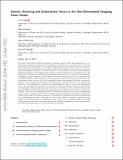| dc.contributor.author | Korolev, K. | |
| dc.contributor.author | Avlund, Mikkel | |
| dc.contributor.author | Hallatschek, Oskar | |
| dc.contributor.author | Nelson, David R. | |
| dc.date.accessioned | 2012-02-13T20:33:40Z | |
| dc.date.issued | 2010 | |
| dc.identifier.citation | Korolev, K. S., Mikkel Avlund, Oskar Hallatschek, and David R. Nelson. 2010. Genetic demixing and evolution in linear stepping stone models. Reviews of Modern Physics 82(2): 1691–1718. | en_US |
| dc.identifier.issn | 1539-0756 | en_US |
| dc.identifier.uri | http://nrs.harvard.edu/urn-3:HUL.InstRepos:8160712 | |
| dc.description.abstract | Results for mutation, selection, genetic drift, and migration in a one-dimensional continuous population are reviewed and extended. The population is described by a continuous limit of the stepping stone model, which leads to the stochastic Fisher-Kolmogorov-Petrovsky-Piscounov equation with additional terms describing mutations. Although the stepping stone model was first proposed for population genetics, it is closely related to “voter models” of interest in nonequilibrium statistical mechanics. The stepping stone model can also be regarded as an approximation to the dynamics of a thin layer of actively growing pioneers at the frontier of a colony of micro-organisms undergoing a range expansion on a Petri dish. The population tends to segregate into monoallelic domains. This segregation slows down genetic drift and selection because these two evolutionary forces can only act at the boundaries between the domains; the effects of mutation, however, are not significantly affected by the segregation. Although fixation in the neutral well-mixed (or “zero-dimensional”) model occurs exponentially in time, it occurs only algebraically fast in the one-dimensional model. An unusual sublinear increase is also found in the variance of the spatially averaged allele frequency with time. If selection is weak, selective sweeps occur exponentially fast in both well-mixed and one-dimensional populations, but the time constants are different. The relatively unexplored problem of evolutionary dynamics at the edge of an expanding circular colony is studied as well. Also reviewed are how the observed patterns of genetic diversity can be used for statistical inference and the differences are highlighted between the well-mixed and one-dimensional models. Although the focus is on two alleles or variants, q-allele Potts-like models of gene segregation are considered as well. Most of the analytical results are checked with simulations and could be tested against recent spatial experiments on range expansions of inoculations of Escherichia coli and Saccharomyces cerevisiae. | en_US |
| dc.description.sponsorship | Physics | en_US |
| dc.language.iso | en_US | en_US |
| dc.publisher | American Physical Society | en_US |
| dc.relation.isversionof | doi:10.1103/RevModPhys.82.1691 | en_US |
| dc.relation.hasversion | http://arxiv.org/abs/0904.4625v2 | en_US |
| dash.license | OAP | |
| dc.subject | stepping stone model | en_US |
| dc.subject | stochastic Fisher-Kolmogorov-Petrovsky-Piscounov equation | en_US |
| dc.subject | selective sweep | en_US |
| dc.subject | voter model | en_US |
| dc.subject | Eden Model | en_US |
| dc.subject | statistical mechanics | en_US |
| dc.subject | populations and evolution | en_US |
| dc.title | Genetic Demixing and Evolution in Linear Stepping Stone Models | en_US |
| dc.type | Journal Article | en_US |
| dc.description.version | Author's Original | en_US |
| dc.relation.journal | Reviews of Modern Physics | en_US |
| dash.depositing.author | Nelson, David R. | |
| dc.date.available | 2012-02-13T20:33:40Z | |
| dc.identifier.doi | 10.1103/RevModPhys.82.1691 | * |
| dash.contributor.affiliated | Nelson, David | |


